Fill your home with the delicious aroma of my bakery-style Condensed Milk Bread. Super soft, fluffy, and light, this makes an impressive bake or enjoyed as an everyday bread recipe.
Unlike other home-baked bread recipes, this loaf retains its soft texture even the day after it has been baked.
Made using basic ingredients, this easy-to-make loaf is perfect for you, especially if it is your first time baking with yeast.
Ingredients
Just a note on ingredients and substitutes if needed
While the full printable recipe is written below, this is the section to read if you’re wondering about ingredient substitutions or how these ingredients work in the recipe.
Milk: Warm milk contributes to richer, soft textured bread. The liquid added to the dry ingredients should be just warm, not too hot or too cold. If you have a thermometer, it should read between 100° – 115°F ( 37°C – 46°C)
Sweetened Condensed milk: Contributes to the tenderness and soft texture of the bread. Adds a slight sweetness when brushed over the baked loaf. Ensure that you are using sweetened condensed milk and not evaporated milk.
Egg: Eggs create a richer textured bread add volume and also bind the ingredients together. You can substitute the egg by using either one of the following:
- Add 1 tablespoon (15ml) lemon juice or vinegar to ¼ cup of milk. Allow the mixture to stand for 5 minutes before using it in the recipe.
- Use ¼ cup plain unflavored yogurt
- ¼ cup buttermilk
Note however that using an egg alternative can affect the texture of the bread. The role of the egg is to add volume creating an airy, soft, and fluffy loaf. Using these alternatives can create a slightly denser loaf. The bread might not stay as fresh on the second day either when alternatives are used. When prepared without the egg, it will be best eaten on the same day it was baked
Sugar: Sugar does more than just add sweetness to the bread. It also helps to feed the yeast which helps the dough to rise.
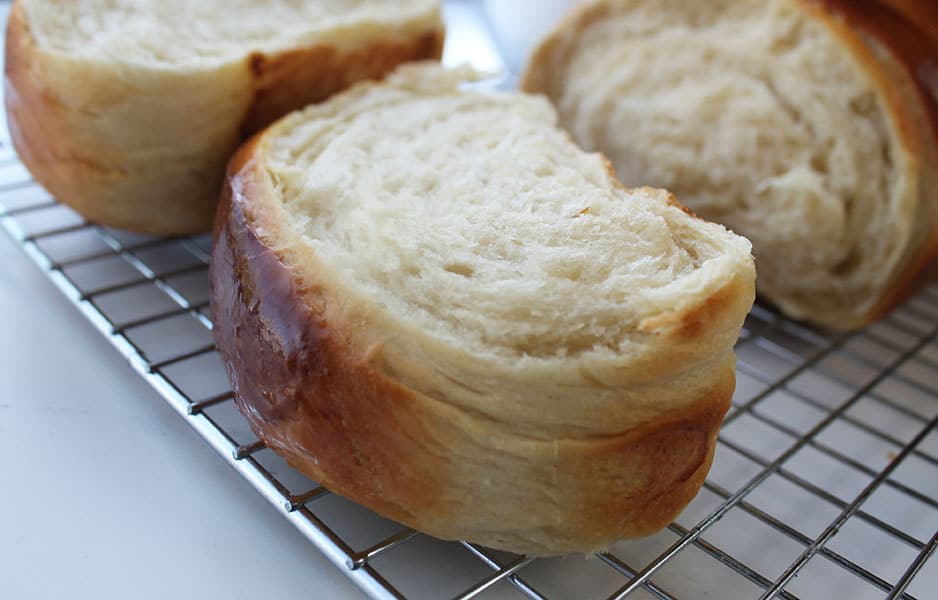
Yeast: I use instant or fast-acting yeast in this recipe.
Use yeast labeled “instant” or rapid rise”. If you can only find normal yeast (usually labeled “active dry yeast”) then dissolve yeast in water first according to package instructions.(no need to let it foam), then immediately add it with the wet ingredients and mix. Proceed with the recipe as written.
Flour: cake or all-purpose flour
Salt
Butter: The softened butter is mixed in only after the dough has been formed and kneaded which develops the gluten. The butter has less effect on the strength of the gluten once it has been formed.
Before you start baking your Condensed Milk Bread
I want you to enjoy baking your condensed milk bread, so for a successful bake every time make sure to check the following before you start baking:
- Make sure that the yeast is fresh and not past the expiry date.
- The milk and condensed milk should be warm. Not too hot or cold as this will affect the yeast. The right temperature ensures that the dough rises well. Any liquid (including the egg substitute, if using) added to the dry ingredients should be just warm, not too hot or too cold. If you have a thermometer, it should read between 100° – 115°F ( 37°C – 46°C).
- The egg used should be at room temperature, so get it out of the fridge at least half an hour before baking.
- Ensure that you are using sweetened condensed milk for this recipe, not evaporated milk.
- You should have the correct size baking tins recommended for this recipe
How to make Condensed Milk Bread
While the video and the full printable recipe are written below, this is the process with step-by-step pictures to guide you.
Whisk the wet ingredients together: Whisk the warmed milk, condensed milk, egg, and yeast in a bowl.
Add in the dry ingredients: Add in the sifted flour and sugar. Mix to combine.
Knead the dough: Use any one of the following methods to knead the dough:
- By hand: Turn the dough out onto a lightly floured surface. Knead for 8 to 10 minutes until the dough is smooth and elastic.
- By a stand mixer or handheld mixer fitter with a dough hook for 5 to 8 minutes until smooth and elastic.

Rub in the butter: Add in the butter, after the dough has been kneaded. Rub the butter into the dough and knead lightly just until combined and the dough is smooth.
Allow the dough to rise: Cover the dough with plastic wrap and leave to rise for between 45 and 60 minutes in a warm, draft-free area of your kitchen.

Punch down the dough: After the dough has risen, punch it down and turn it out of the bowl onto a well-floured surface. Knead for 1 minute. Shape the dough with your hands to form a small rectangle. This is going to make it easier for you to roll out into a rectangular shape.
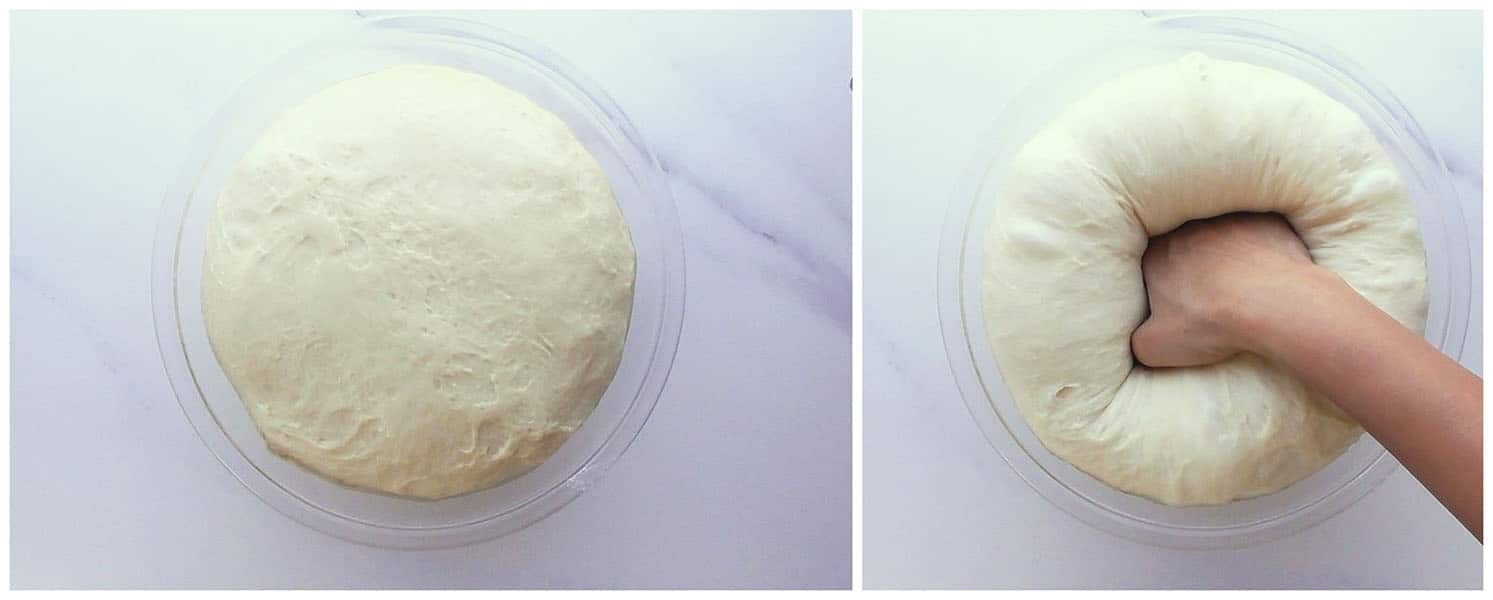
Roll out the dough: Use a rolling pin to roll out the dough to approximately 12x17 inches ( 30x42cm)
Roll up and seal: Starting from the shorter side, (the side measuring 12 inches (30cm) roll up the dough tightly into a log shape.

Seal to close: Pinch the edges closed to seal. Roll the log gently with your hands to smooth out the sealed edge.
Cut the dough: Use a sharp knife to cut and divide the rolled-up dough into approximately 8 pieces about 1 ½inches (4cm) thick
Arrange pieces into a loaf baking pan: Place the pieces into one large 12 x 4⅓x 3¾″ (30.5 x 11 x 9.5 cm) loaf pan OR into two standard 22 x 13 cm / 9 x 5" loaf ( 22 x 13 cm) pans.
Allow the cut pieces to rise for another 45 minutes: This is the second rise where the cut pieces of dough rise for another 45 minutes. The second rise is responsible for the superior flavour and texture of the bread. It allows the yeast more time to work, helping to develop a lighter, chewier texture, creating amazing flavor. Allow to rise for 45 minutes covered with a cloth.
Brush with a mixture of milk and egg: Brushing with egg and milk creates a shiny and golden color of the crust. If you do not want to use an egg, just leave it out and brush it with milk instead. However, using milk on its own will not produce a shiny crust.

Bake: Preheat oven to 180°C/350°F (160°C fan oven). Bake for between 20-25 minutes until golden brown and baked through.
Make the glaze: In a small bowl, combine the condensed milk and melted butter and set aside.

Remove from the oven: Remove the baked bread from the oven. Turn out the bread from the baking tin and brush with the prepared glaze. Allow the glaze to dry on the bread for a few minutes before slicing.

Tips and frequently asked questions
Which baking pan to use
This loaf can be baked in either 2 standard loaf pans 22 x 13 cm / 9 x 5" loaf ( 22 x 13 cm) or in one large 12 x 4⅓x 3¾″ (30.5 x 11 x 9.5 cm) loaf pan.
To bake in 2 pans, simply divide the dough in half before rolling out.
What happens if you don't allow the bread dough to rise for the specified time?
Allowing the bread to rise first after kneading and second after shaping is an important step and should not be skipped.
During the first rise the yeast ferments (absorbs) the sugar and develops the dough.
The second rise is responsible for the superior flavor and texture of the bread. It allows the yeast more time to work, helping to develop a lighter, chewier texture, creating amazing flavor. Allow the dough to rise for 45 minutes covered with a cloth.
Why did my baked bread turn out dense and hard?
When placing the shaped dough into the baking pan for a second rise, ensure that it is not set too tightly. The dough needs space to expand during the second rise and baking.
Follow the recommended baking pan sizes in this recipe for the best results. If you do not have a large 12 x 4⅓x 3¾″ (30.5 x 11 x 9.5 cm) loaf pan, then just divide the shaped dough and place it into two standard 22 x 13 cm / 9 x 5" loaf ( 22 x 13 cm) pans.
An incorrect pan size will result in an uneven-shaped baked loaf or a dense loaf especially if the pan is too small.
This recipe uses just ¼ cup of condensed milk. So what to do with the leftover condensed milk? Here are a few great recipes for you to use up your leftover condensed milk:
- Sweetened Condensed Milk Shortbread Cookies
- Condensed Milk Coconut Tarts
- 4 ingredients Condensed Milk Chocolate Cookies
Enjoy ♥
Condensed Milk Bread
Ingredients
For the bread
- 1 cup milk warmed see note 1
- ¼ cup sweetened condensed milk
- 1 egg at room temperature or substitute see note 2
- 2 Tablespoons white granulated sugar
- 3 teaspoons instant/rapid rise yeast see note 3
- 3 ¼ cups cake flour OR all purpose flour
- 1 teaspoon salt
- ¼ cup butter softened, not melted
For the glaze
- 1 Tablespoon butter softened
- 1 Tablespoon sweetened condensed milk
Instructions
To make the bread
- Whisk the wet ingredients together: Whisk the warmed milk, condensed milk, egg, and yeast in a bowl.
- Add in the dry ingredients: Add in the sifted flour, salt and sugar. Mix to combine.
- Knead the dough: Use any one of the following methods to knead the dough:By hand: Turn the dough out onto a lightly floured surface. Knead for 8 to 10 minutes until the dough is smooth and elastic.By a stand mixer or a handheld mixer fitted with a dough hook for 5 to 8 minutes until smooth and elastic.
- Rub in the butter: Add in the butter, after the dough has been kneaded. Rub the butter into the dough and knead lightly just until combined and the dough is smooth.
- Allow the dough to rise: Cover the dough with plastic wrap and leave to rise for between 45 and 60 minutes in a warm, draft-free area of your kitchen.
- Punch down the dough: After the dough has risen, punch it down and turn it out of the bowl onto a well-floured surface. Knead for 1 minute. Shape the dough with your hands to form a small rectangle. This is going to make it easier for you to roll out into a rectangular shape.
- Roll out the dough: Use a rolling pin to roll out the dough to approximately 12x17 inches ( 30x42cm)
- Roll up and seal: Starting from the shorter side, (the side measuring 12 inches (30cm) roll up the dough tightly into a log shape.
- Seal to close: Pinch the edges closed to seal. Roll the log gently with your hands to smooth out the sealed edge.
- Cut the dough: Use a sharp knife to cut and divide the rolled-up dough into approximately 8 pieces about 1 ½inches (4cm) thick
- Arrange pieces into a loaf baking pan: Grease and line with baking paper a large 12 x 4⅓x 3¾″ (30.5 x 11 x 9.5 cm) loaf pan OR into two standard 22 x 13 cm / 9 x 5" loaf ( 22 x 13 cm) pans.Place the pieces into the preferred pan. See note 4
- Allow the cut pieces to rise for another 45 minutes: This is the second rise where the cut pieces of dough rise for another 45 minutes. The second rise is responsible for the superior flavor and texture of the bread. It allows the yeast more time to work, helping to develop a lighter, chewier texture, creating amazing flavor. Allow the shaped pieces to rise for 45 minutes covered with a cloth.
- Brush with a mixture of milk and egg: Brushing with egg and milk creates a shiny and golden color of the crust. If you do not want to use an egg, just leave it out and brush it with milk instead. However, using milk on its own will not produce a shiny crust.
- Bake: Preheat oven to 180°C/350°F (160°C fan oven). Bake for between 20-25 minutes until golden brown and baked through.
Make the glaze:
- Make the glaze: Prepare the glaze while the bread is in the oven. In a small bowl, combine the condensed milk and melted butter and set aside.
- Remove from the oven: Remove the baked bread from the oven. Turn out the bread from the baking tin and brush with the prepared glaze. Allow the glaze to dry on the bread for a few minutes before slicing.
Video
Notes
- The milk and condensed milk should be warm. Not too hot or cold as this will affect the yeast. The right temperature ensures that the dough rises well. Any liquid (including the egg substitute, if using) added to the dry ingredients should be just warm, not too hot or too cold. If you have a thermometer, it should read between 100° – 115°F ( 37°C – 46°C).
- You can substitute the egg by using either one of the following: Add 1 tablespoon (15ml) lemon juice or vinegar to ¼ cup of milk. Allow the mixture to stand for 5 minutes before using it in the recipe OR Use ¼ cup plain unflavored yogurt OR ¼ cup buttermilk. Note however that using an egg alternative can affect the texture of the bread. The role of the egg is to add volume creating an airy, soft, and fluffy loaf. Using these alternatives can create a slightly denser loaf. The bread might not stay as fresh on the second day either when alternatives are used. When prepared without the egg, it will be best eaten on the same day it was baked
- Use yeast labeled “instant” or “rapid rise”. If you can only find normal yeast (usually labeled “active dry yeast”) then dissolve yeast in water first according to package instructions.(no need to let it foam), then immediately add it with the wet ingredients and mix. Proceed with the recipe as written
- When placing the shaped dough into the baking pan for a second rise, ensure that it is not set too tightly. The dough needs space to expand during the second rise and baking. Follow recommended baking pan sizes in this recipe for the best results. If you do not have a large 12 x 4⅓x 3¾″ (30.5 x 11 x 9.5 cm) loaf pan, then just divide the shaped dough and place it into two standard 22 x 13 cm / 9 x 5" loaf ( 22 x 13 cm) pans.

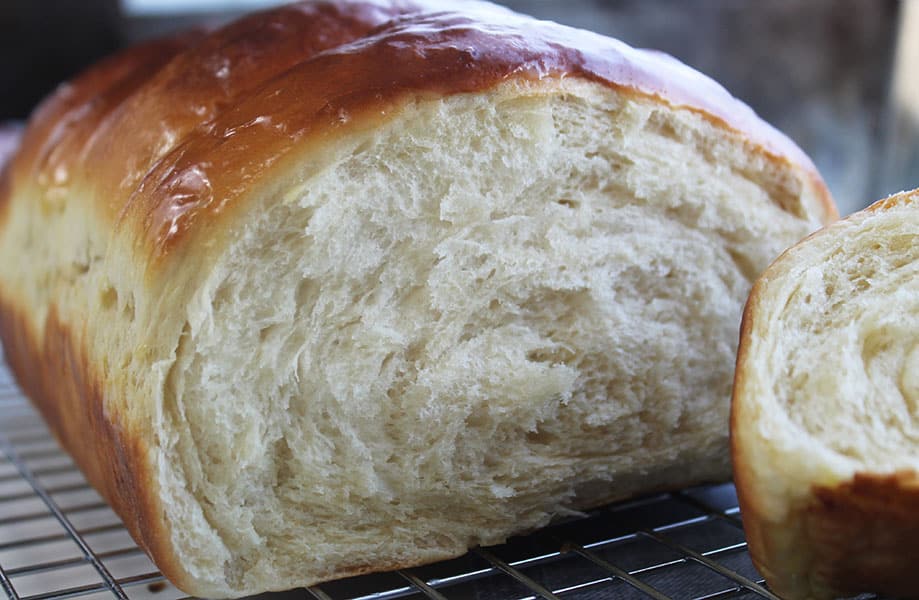
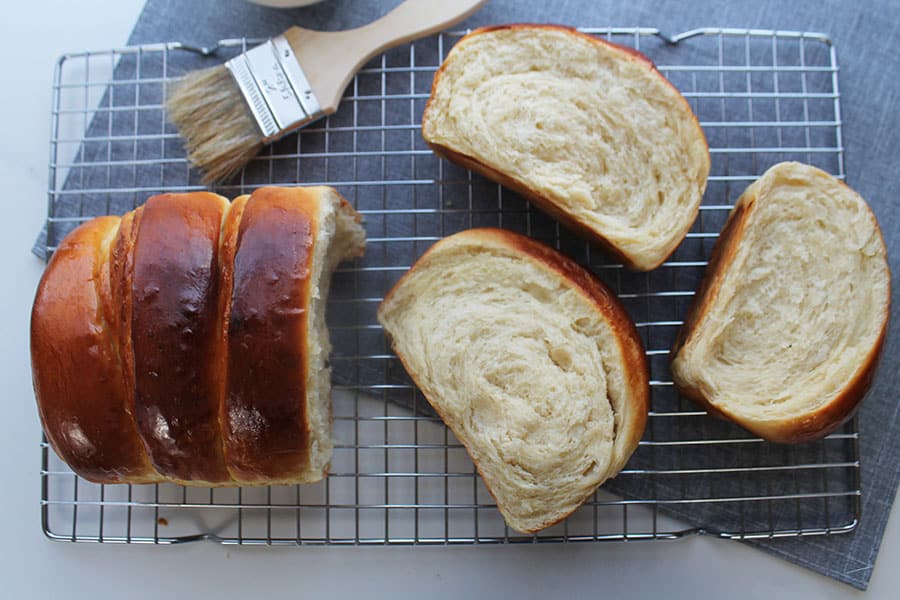
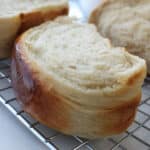
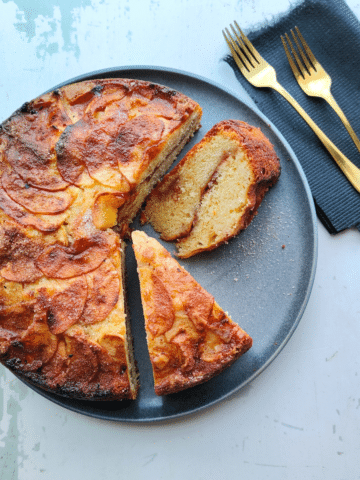
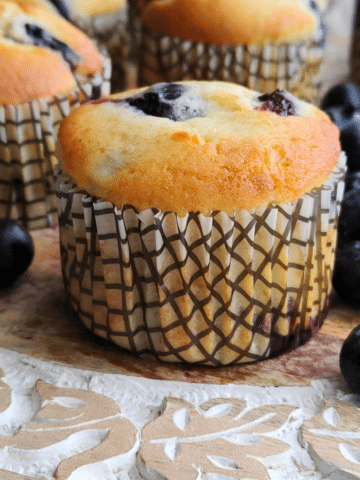
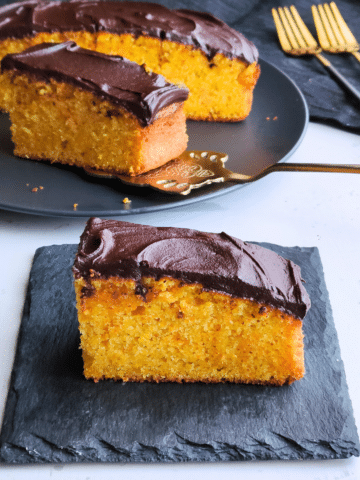
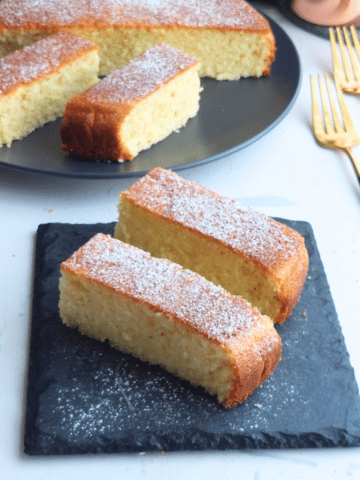

Laura says
This light and fluffy bread looks amazing - I can think of so many ways to use it!